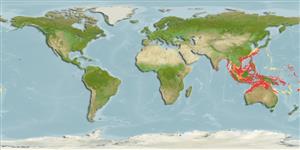>
Eupercaria/misc (Various families in series Eupercaria) >
Priacanthidae (Bigeyes or catalufas)
Etymology: Priacanthus: Greek, prion = saw + Greek, akantha = thorn (Ref. 45335).
More on author: Cuvier.
Environment: milieu / climate zone / depth range / distribution range
Écologie
marin récifal; océanodrome (Ref. 51243); profondeur 12 - 400 m (Ref. 90102). Subtropical; 32°N - 22°S
Western Pacific: southern Japan to western Indonesia, the Arafura Sea (Ref. 9819), and Australia. Reported from Peter the Great Bay (Ref. 27683).
Taille / Poids / Âge
Maturity: Lm ? range ? - ? cm
Max length : 30.0 cm SL mâle / non sexé; (Ref. 48635)
Épines dorsales (Total) : 10; Rayons mous dorsaux (Total) : 12 - 14; Épines anales: 3; Rayons mous anaux: 13 - 14. Medium-sized fish of moderately deep body. The eyes large; the mouth oblique, with the lower jaw projecting upwards. The body tapers very slightly to beneath the middle of the soft portion of the dorsal fin, and then abruptly to the peduncle. This species is distinguished from P. fitchi by the presence of numerous rusty brown to yellowish spots in the membranes of the dorsal and anal fins, and its less tapered body.
Occurs in inshore and offshore reefs from less than 20 m to more than 400 m depths. Apparently forms aggregations in open bottom areas and is very abundant in the South China Sea and Andaman Sea. Marketed fresh, whole. Sound production has been studied in this species. Also found under ledges or hovering next to coral heads during day (Ref 90102).
Life cycle and mating behavior
Maturité | Reproduction | Frai | Œufs | Fécondité | Larves
Starnes, W.C., 1988. Revision, phylogeny and biogeographic comments on the circumtropical marine percoid fish family Priacanthidae. Bull. Mar. Sci. 43(2):117-203. (Ref. 5403)
Statut dans la liste rouge de l'IUCN (Ref. 130435: Version 2024-2)
Menace pour l'homme
Harmless
Utilisations par l'homme
Pêcheries: commercial
Outils
Articles particuliers
Télécharger en XML
Sources Internet
Estimates based on models
Preferred temperature (Ref.
123201): 16.9 - 28, mean 24.4 °C (based on 682 cells).
Phylogenetic diversity index (Ref.
82804): PD
50 = 0.5002 [Uniqueness, from 0.5 = low to 2.0 = high].
Bayesian length-weight: a=0.01660 (0.01258 - 0.02189), b=2.91 (2.84 - 2.98), in cm total length, based on LWR estimates for this species (Ref.
93245).
Niveau trophique (Ref.
69278): 4.1 ±0.60 se; based on food items.
Generation time: 1.5 (1.1 - 2.2) years. Estimated as median ln(3)/K based on 15
growth studies.
Résilience (Ref.
120179): Milieu, temps minimum de doublement de population : 1,4 à 4,4 années (K=0.7-1.0; tmax=6).
Prior r = 0.32, 95% CL = 0.21 - 0.48, Based on 1 data-limited stock assessment.
Fishing Vulnerability (Ref.
59153): Low vulnerability (18 of 100).
Climate Vulnerability (Ref.
125649): High vulnerability (63 of 100).
Nutrients (Ref.
124155): Calcium = 42.3 [23.6, 84.7] mg/100g; Iron = 0.931 [0.514, 1.629] mg/100g; Protein = 20 [19, 21] %; Omega3 = 0.298 [0.158, 0.546] g/100g; Selenium = 28.8 [13.0, 59.1] μg/100g; VitaminA = 42.2 [14.1, 133.0] μg/100g; Zinc = 0.722 [0.458, 1.100] mg/100g (wet weight); based on
nutrient studies.
